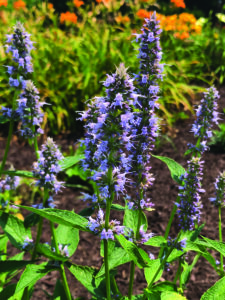
The soft lavender blue color of the Agastache Blue Fortune’s fragrant flowers is a complement to the silvery green fragrant leaves that are attached to the square stem opposite from each other. (Photo by Ginny Rosenkranz)
Agastache Blue Fortune is also called Hummingbird Mint because when Blue Fortune blooms, the brightly colored hummingbirds visit the fragrant nectar rich flowers.
The tiny tubular flowers line up and around of the top of the 3 to 5 inches of the flower spikes, looking almost like a tiny bottle brush.
The soft lavender blue color of the fragrant flowers is a complement to the silvery green fragrant leaves that are attached to the square stem opposite from each other.
Hummingbird Mint leaves have a strong licorice or anise fragrance and they can be added to flavor cold drinks during the heat of summer.
Blue Fortune plants love to grow in full sun and excellent drainage, becoming very drought tolerant once it is established.
Unfortunately, it will not tolerate heavy clay or soils that are poorly drained.
The plants grow in a sturdy clump with erect branched stems that can reach 2-3 feet tall and spread 1 1/2 to 2 feet wide.
Plants will begin to bloom with their showy flowers covered with pollinators in the heat of July and continue to add fragrant colorful flowers until October, making it a wonderful addition to the last summer and fall gardens.
A lot of colorful pollinators will visit the nectar rich flowers including many butterflies, bees, hummingbirds and in the fall the song birds will feast on the fruit.
These fragrant flowers can be planted as a mass planting, in a butterfly and pollinators garden, cottage gardens, cutting gardens, sensory gardens and as a boarder along a walkway or along the edge of a garden.
Possibly one of the best attributes of Hummingbird Mint is that the fragrance of the flowers and the leaves are excellent deterrents to both rabbits and deer that want to feast on our flower gardens.
(Editor’s Note: Ginny Rosenkranz is a commercial horticulture specialist with the University of Maryland Extension.)



